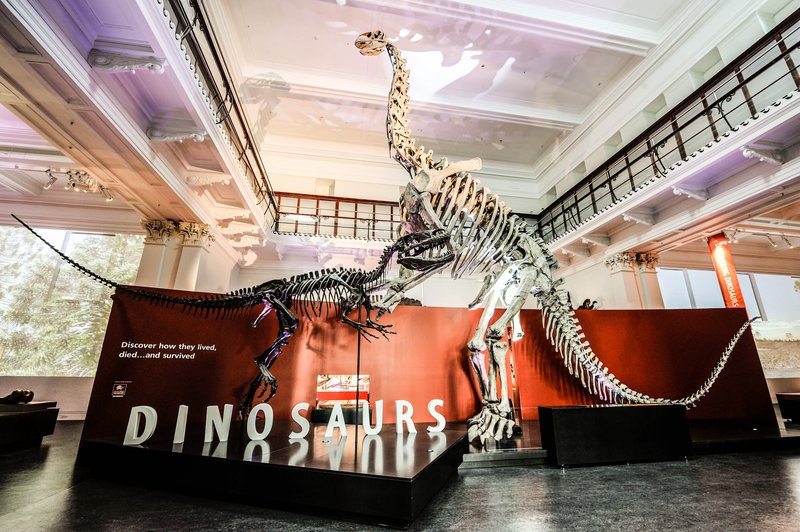Dinosaurs
Discover the amazing world of dinosaurs in this exhibition that brings the Mesozoic era to life.

Do you know an Afrovenator from a Jobaria? Or a Stegosaurus from a Giganotosaurus?
Whether you’re a palaeontologist in the making or just a fan of Jurassic Park, you’ll be fascinated by the prehistoric world as you walk amongst real dinosaur skeletons and life-size models, as well as the fossil teeth, skulls and claws of these out-of-this-world creatures.
Learn about dinosaurs, like the Muttaburrasaurus, that once roamed Australia. Be awed by the skull of a Centrosaurus, and compare the bird-like features of the Bambiraptor to the only dinosaurs still living today, modern birds. With our interactive displays you can smell the Mesozoic world, make dinosaur calls and even see the world from a dinosaur's perspective.
Be sure not to miss the world’s first anatomically correct model of a T.rex – a dissected 11-metre long replica created for the documentary, T.rex Autopsy, donated to the Australian Museum by National Geographic.
Exhibition highlights

Minmi paravertebra
Get up close and personal with the Minmi paravertebra, a four-legged, plant-eating dinosaur armoured with hard ridged scales along it's entire body providing a tough exterior to protect against predators. No wonder it's known as 'nature's tank'!

Jobaria tiguidensis and Afrovenator abukensis
Meet Jobaria tiguidensis and Afrovenator abukensis from Africa. Belonging to a family of giant plant-eating dinosaurs called sauropods, Jobarias were the length of a truck with a neck the size of a whole giraffe! Afroventors, on the other hand were built for speed and power with long jaws and big spiky teeth.

Muttaburrasaurus
The Muttaburrasaurus langdoni is named after the town of Muttaburra in Queensland, where the fossil was discovered by a farmer, Doug Langdon, in 1963. This plant-eating dinosaur roamed the earth in the Early Cretaceous Period, 112–100 million years ago.

Tyrannosaurus rex
Tyrannosaurus rex, or the ‘Tyrant Lizard King’, roamed the North American landscape of forests and open plains and rivers, during the Late Cretaceous period, 68 to 66 million years ago. Explore the world’s first anatomically correct model of a T.rex. Discover how the 65 million year-old-beast lived, and the cause of its death.
Related information
Subscribe to our eNewsletter
Keep up to date on events, new exhibitions, special offers and scientific discoveries with our What's On eNewsletter. Receive the latest news on school holiday programs and much more!
Sign up now








